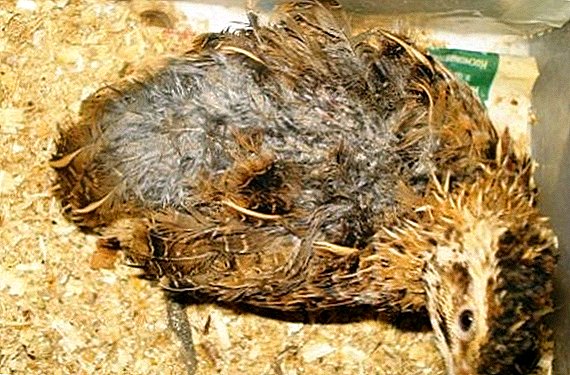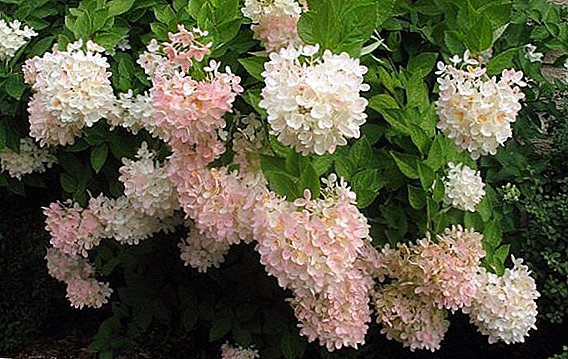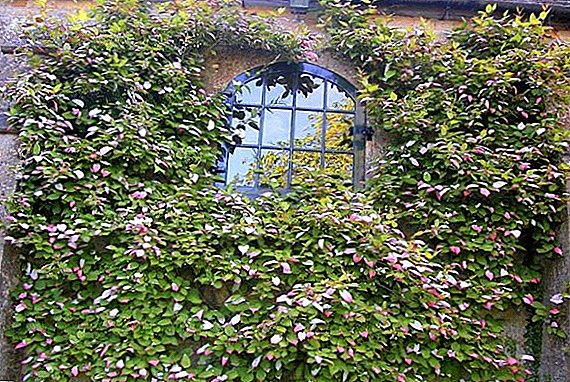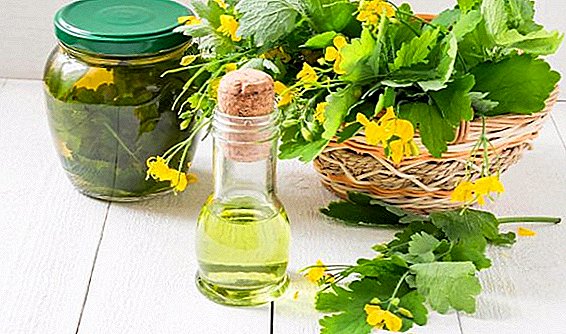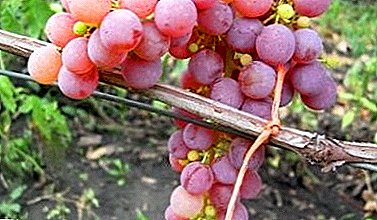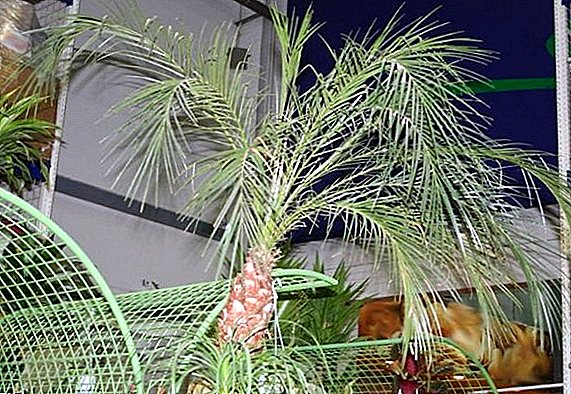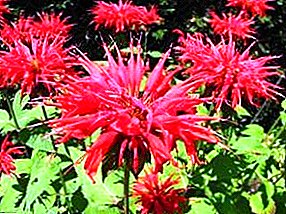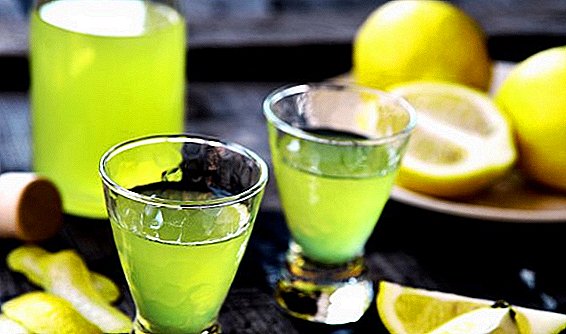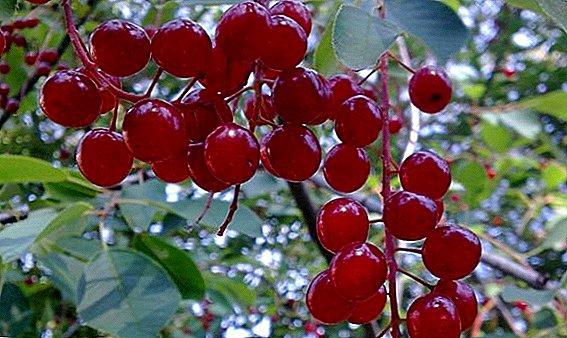 The sweet taste of cherries and the light sourness of cherries in one big berry - such a combination, except in a dream, is an inveterate botanist. But in nature, everything is possible, and even more so if breeders are taken for the improvement of random pollination. As a result, gardeners were given the opportunity to cultivate the dyuk or, as they are called, pottery. Large fragrant berries amaze with the appearance and taste, and trees - with productivity. How to grow such a miracle at the site, we will tell in this article.
The sweet taste of cherries and the light sourness of cherries in one big berry - such a combination, except in a dream, is an inveterate botanist. But in nature, everything is possible, and even more so if breeders are taken for the improvement of random pollination. As a result, gardeners were given the opportunity to cultivate the dyuk or, as they are called, pottery. Large fragrant berries amaze with the appearance and taste, and trees - with productivity. How to grow such a miracle at the site, we will tell in this article.
Duke: what is this miracle
 For many lovers of fruit and berry plants, the cottage is a wonder from the world of fiction. We will understand what it is and what is more in the berries - cherries or sweet cherries.
For many lovers of fruit and berry plants, the cottage is a wonder from the world of fiction. We will understand what it is and what is more in the berries - cherries or sweet cherries.
Scientifically, Duke is a hybrid of both cultures. Moreover, the pollination of these trees happened by chance approximately in the XVII century.
Such a synthesis interested breeders, and over time they took up the purposeful breeding of such seedlings.
Did you know? The word "Duke" to refer to the hybrids of the trees is used only by Slavic peoples, and in Europe it has not taken root. This name originated from the popular variety "May Duke", which means "May Duke".
On the post-Soviet territory, the first duke appeared in the 90s in crossbreeding Belle cherries and Winkler white cherries. Scientists have meant its cultivation in the northern regions, therefore, instilled a high resistance to frost. But too harsh winters were stronger than delicate buds, and the tree gave a meager harvest.
Western specimens, which brought in our latitudes, also disappointed gardeners with their thermophilic characteristics, causing a lot of trouble with wintering. Of the few varieties of trees, the majority turned out to be fruitless, some gave a low yield.
Today, the picture has changed dramatically. Breeders took years of hard work to please garden gardeners with resistant hybrids to diseases and cold. In addition, finally managed to achieve high yields.  Since the duk is hybrid cherries and cherries, there are qualities of both species in it, although there are slightly more cherry manifestations.
Since the duk is hybrid cherries and cherries, there are qualities of both species in it, although there are slightly more cherry manifestations.
Outwardly, it is a small tree with a neat compact crown, symmetrical branches, oblong glossy leaves, white inflorescences and sweet large fruits of red-cherry color.
The shape and density of the leaves, the aroma of berries, their taste, winter hardiness culture closer to the cherry, and the size of the fruit, their sugar content - to the sweet cherry. On average, one berry hangs around 15–20 g. Trees enter the fruiting phase in the third or fourth year, bringing 10 kg of berries per season.
We recommend that you familiarize yourself with the list of early and medium ripening cherry varieties, as well as yellow and late ripening cherry varieties for your garden.
Top Grades
A different set of chromosomes of cherries and cherries greatly complicated the task set by botanists for breeding varietal variety of ducks. That is why the choice in the domestic selection for a long time was very scarce. Among European proposals in the last century, varieties of French production "Queen Hortensia", "Empress Eugenia" were in demand.  Today they have been squeezed by their relatives:
Today they have been squeezed by their relatives:
medium early
- "Saratovskaya baby" (characterized by high yields of medium-growth tree and large dessert berries, which are hidden in the thick of the crown and are not accessible to birds);
- “Wonderful Cherry” (it is notable for drought tolerance, pathogenic microbes and severe winters; it produces high yields every year);
- "Pivon" (deserves attention due to the taste of the crop);
- "Hodosa" (is a hardy tree, giving large and juicy sweet-sour-tasting berries;
- "Spartan" (a feature of this duck variety is in high frost resistance, therefore it is recommended for the northern regions);
- "Prenatal" (externally this is a tall tree with large juicy fruits);
- "Nurse" (variety is the best in fruit quality);
- "Theanna" (the berries of this variety can be safely called the standard of cherry flavor);
- "Ivanovna" (is a leader in the varietal diversity of this group and is a low tree with large red berries);
- "Night" (the breed's advantage lies in the genes for confronting the causative agents of moniliosis and cocomicosis);
- "Excellent Venyaminova" (feature of the variety - in dense fleshy berries).

Important! Buying seedlings of the pot, be careful. Sometimes they are sold without indication of the variety under the generalized inscription "Duk" or "cherry-cherry". The danger of such seedlings is in their incomprehensible origin, as often rejected specimens with poor fruit-bearing and winter-hardy characteristics of maternal genes are realized in this form..
Choosing a site for growing pottery
To wondrous cherry thanked you with a bountiful harvest, it needs to find the right place. Otherwise, your site will be a barren tree. For full development penumbra is important penumbra, protection from cold winds and drafts, as well as rich in nutrients soil with an acid reaction at pH 7.
Cultivation in lowland areas, where a lot of water accumulates in summer and cold air in winter, will not work.
Important! For abundant fruiting, the dules should be planted next to the cherries, since they themselves do not pollinate and do not perceive the pollen of cherries.
Perfect there will be a plot with diffused light and sandy substrate. If there is no such thing in your compound, it is worthwhile to take care in advance of creating conditions for the church. Acidic soils should be neutralized with 1.5 kg of chalk, and heavy clay soil should be replaced at the landing site with a mixture of equal parts of fertile soil and sand.
But this is not all the whims of the dukes. They must grow in close proximity to cherries and cherries, because they are not capable of self-pollination. For fruiting near enough 2-4 trees.
Did you know? In ancient times, our ancestors made dyes for food from cherries, and they were not purple, but green.
Planting rules seedlings
The main guide when planting seedlings of this variety of fruit crops is to maintain the necessary distance between the trees and competent preparation of the hole. In all other respects, planting and leaving a house is no different from its fellow counterparts.  Perfect rooting time seedlings is early spring, but the earth should warm up well. To begin with, make a recess on the chosen place at the level of 1 meter with a diameter up to 70 cm. Other cultures should be no closer than 5 meters. At the bottom of the pit lay the drainage, on top - embankment of a previously prepared mixture of rotted manure and a fertile layer of earth.
Perfect rooting time seedlings is early spring, but the earth should warm up well. To begin with, make a recess on the chosen place at the level of 1 meter with a diameter up to 70 cm. Other cultures should be no closer than 5 meters. At the bottom of the pit lay the drainage, on top - embankment of a previously prepared mixture of rotted manure and a fertile layer of earth.
An alternative option may be mineral fertilizers: 0.5 kg of superphosphate and 300 g of potassium sulfate. Tree deeply deepen not recommended, because the buried root neck will cause rot and death of the hybrid. After digging in the straightened root system, do not forget to shake the trunk thoroughly to fill the underground voids in the roots, and water the plant abundantly. It will take about two buckets of water.
Did you know? About 40 kilograms of bee pollen is collected from one hectare of cherry and cherry orchards.
How to care for a hybrid: the proper cultivation of the duck
In the care of the ducks require less attention than other garden plants. For example, they do not need to feed. And all because the increased nutrition provokes the development of wood, but, unfortunately, by the winter period it does not have time to get stronger and at best leads to sterility of culture, and at worst - to its death.
Watering, crown formation and tree trunnion treatment remain important for the cultivation of trees. But about all this in order.
Frequency and abundance of irrigation
Like all stone fruits, these hybrids do not need frequent irrigation. Excess moisture leads to cracks in the trunk and skeletal branches, and also provokes rotting rhizomes. In order not to bring the tree to such tests, it should be watered only during long droughts.
Young seedlings up to the age of five should preferably be moistened more often, since a lack of water will cause the roots to dry out. Do not allow strong drying of the ground in pristvolnyh circles. The frequency of irrigation depends on weather conditions. Use water is not cold water, each time defending it.
Important! The best varieties for ducks are the following varieties of sweet cherries: "Annushka", "Donchanka", "Sister", "Homestead".
Correct pruning
First pruning cherry-cherries are made immediately after planting the seedling. At the level of 60 cm from the ground, he cut off the tops of the trunk and skeletal branches. On second-year copies, one-third of the side shoots are shortened. Gardeners noticed that before the start of fruiting, trees are characterized by intensive growth, with the appearance of the first crop, the branches stop growing.
For old trees, spring rejuvenating pruning matters, which is to remove sprouts along the entire crown to the level of 4-year-old trees. This procedure is repeated every five to six years.
Crown thickening should not be allowed, since the quantity and quality of the berries depends on this factor. When making a haircut, pay attention to the angle of separation of the shoots from the trunk - the bigger it is, the less pruning.
Digging and mulching wheel circle
Some gardeners sow green manure on large areas in order to fertilize the emaciated soil. In the case of the dukes, this option is quite acceptable, but pristvolny circles should always remain under the black steam. They regularly regularly mandatory remove weeds and loosen the soil. And it is better to do it after watering.
The dug up earth without obstacles allows air to flow to the roots, which is vital for stone fruit plants. To form a specific wet microclimate, the substrate around the stems of the trees is advised to mulch with hay. This helps trees protect the roots in winter and retains moisture. In no case Do not scatter mulch on dry ground.
Did you know? Duck fruits can reach 2 cm in volume.
Frost and Rodent Protection
The forest has frost-resistant properties, therefore, special preparatory work for wintering with timely mulching of the tree trunk does not require. Varieties with a weak resistance gene to cold require more attention, especially in the northern regions.
The most common method is to cover the root part of the trunk with snow, and the above-ground part - with dense polyethylene. Young trees under five years of age also need such manipulations.  Some gardeners share the experience of wrapping the trunk with spruce or burlap. This method allows you to simultaneously solve two problems: protect the bark from being eaten by rodents and protect the root part of the trunk from frost. You can scare away hungry hares with the help of a sheet of tar.
Some gardeners share the experience of wrapping the trunk with spruce or burlap. This method allows you to simultaneously solve two problems: protect the bark from being eaten by rodents and protect the root part of the trunk from frost. You can scare away hungry hares with the help of a sheet of tar.
Find out how you can save your favorite berry to feast on it in the winter.
Useful properties of duck berries
The benefits of berries are scientifically proven. In the laboratory, the researchers found that the appetizing fruits are not only delicious, but also have antibacterial action, improve appetite, and have a beneficial effect on the human body in disorders of the gastrointestinal tract, nervous breakdowns, diseases of the throat and bronchi, gout, arthritis, anemia.
Oncologists are convinced that the juice of the fruit duke blocks the development of tumors. In addition, the wonder berries are low-calorie foods. 100 g of fruit is only 50 Kcal, 0.5 g of fat, 0.8 g of protein and 0 g of carbohydrates.


